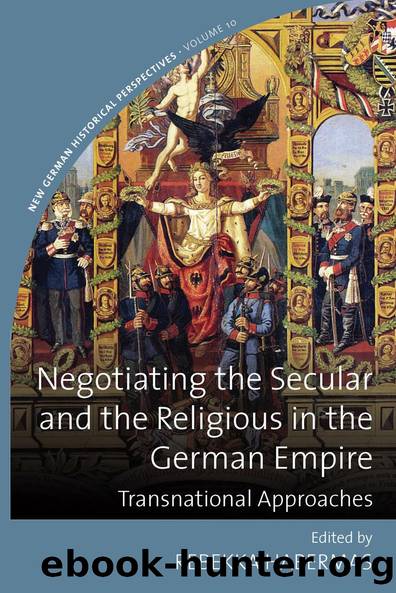Negotiating the Secular and the Religious in the German Empire by Rebekka Habermas

Author:Rebekka Habermas [Habermas, Rebekka]
Language: eng
Format: epub
ISBN: 9781789201512
Barnesnoble:
Publisher: Berghahn Books, Incorporated
Published: 2019-03-27T00:00:00+00:00
Who Is Secular? Common Sense and Its Entanglements: Male and of Caucasian Race
The most uncontroversial, almost basic assumption shared by many, if not almost all, engaged in debates on secular phenomena or on ideas defined as secular, is that secular individuals are mostly men. People marked as representatives of the secular in cartoons, for instance, may be of middle- or lower-class background, they may be socialists, liberals or sometimes even conservatives, but they were always depicted as male. Being female and secular seemed to be a contradictio in adiecto.
That masculinity and secularity were deemed to be intertwined comes as no surprise in the light of the emerging contemporary notion of hegemonic masculinity. As Isabel Hull has shown, hegemonic masculinities in the course of the eighteenth century turned away from noble ideals, as described by Baldasare Castiglione in his Libro de Cortegano, to the new concept of a masculine achiever â a man in a dark suit, symbolizing austerity, modesty, sobriety and authority, as well as reason and self-discipline.34 According to these mainstream gender stereotypes emerging around 1800, and fully established by the end of the nineteenth century, men could also be identified with being less and less connected to a domestic and pious space, whereas religion became more and more ascribed to a female, and thus private, sphere.
This seemingly natural interconnectedness of masculinity and the secular becomes even more obvious when we turn to the other side of the coin, and notice that an increasingly close identification of femininity with the religious was developing in contemporary minds. In contrast to the already mentioned nearly complete lack of studies on the secular, and its identification with manliness, the female, and therefore religious, side of the coin has systematically been explored and is now known under the umbrella term of âfeminization of religionâ.35 This term refers to a broad contemporary discourse, constructing women as beings of higher sensibility, particularly regarding religion. It was widely believed that women were more susceptible to religion, and that all sorts of female activities, particularly in the private sphere, were religion-centred. Women at that time were described as being engaged in what scholars today call a âprivatization of pietyâ, emphasizing their internal reflections and relationship to God.36 Their gender identity thereby became closely connected to the religious sphere.37 Not only novels but also medical manuals and advice books depicted women as deeply involved in religious matters. And by increasingly relegating religion and women to the realm of the private, religious women were accurately separated from the public of secularism.38 Even though we have to be very cautious not to misunderstand the wide range of female activities in associations only loosely connected to religious institutions as signs of deep religious devotion, it is obvious that the normative as well as imaginative side of middle-class gender boundaries were rearranged according to the poles of the religious and the secular. This becomes even more obvious in particularly intense situations of religious confrontation, as described by Michael B. Gross in his book on anti-Catholicism.
Download
This site does not store any files on its server. We only index and link to content provided by other sites. Please contact the content providers to delete copyright contents if any and email us, we'll remove relevant links or contents immediately.
Getting It, Then Getting Along by L. Reynolds Andiric(631)
Religion and Politics Beyond the Culture Wars : New Directions in a Divided America by Darren Dochuk(451)
Global Justice, Christology and Christian Ethics by Lisa Sowle Cahill(411)
Positive Psychology in Christian Perspective: Foundations, Concepts, and Applications by Charles Hackney(342)
Forgiveness and Christian Ethics by Unknown(329)
Douglas Hamp The First Six Days by Unknown(257)
The Horrors and Absurdities of Religion by Arthur Schopenhauer(243)
Insurgency, Counter-insurgency and Policing in Centre-West Mexico, 1926-1929 by Mark Lawrence(234)
Christian Martyrdom and Christian Violence by Matthew D. Lundberg;(223)
The Oxford Handbook of Greek and Roman Mythography by R. Scott Smith;Stephen M. Trzaskoma;(217)
Beyond Heaven and Earth by Gabriel Levy(210)
God and Eros by Patterson Colin;Sweeney Conor;(208)
The Bloomsbury Reader in Christian-Muslim Relations, 600-1500 by David Thomas;(205)
Autobiography, Volume 2: 1937-1960, Exile's Odyssey by Mircea Eliade(197)
Cult Trip by Anke Richter(194)
Witches: the history of a persecution by Nigel Cawthorne(192)
An Introduction to Kierkegaard by Peter Vardy(179)
The Myth of Disenchantment by Jason A. Josephson-Storm(174)
The Global Repositioning of Japanese Religions by Ugo Dessi(173)
